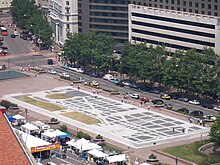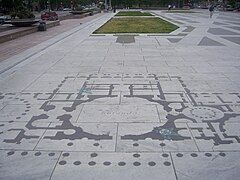Freedom Plaza
 Freedom Plaza in Washington, D.C. in 2005 | |
| Location | Northwest Washington, D.C., U.S. |
|---|---|
Freedom Plaza, originally known as Western Plaza, is an open plaza in Northwest Washington, D.C., United States, located near 14th Street and Pennsylvania Avenue NW, adjacent to Pershing Park. The plaza features an inlay that partially depicts Pierre (Peter) Charles L'Enfant's plan for the City of Washington. The National Park Service administers the Plaza as part of its Pennsylvania Avenue National Historic Site and coordinates the Plaza's activities.[1]
The John A. Wilson Building, the seat of the District of Columbia government, faces the plaza, as does the historic National Theatre, which has been visited by every U.S. president since it opened in 1835.[2][3] Three large hotels are to the north and west. The Old Post Office building, which houses the Waldorf Astoria Washington D.C., is to the southeast.[4]
History
[edit]20th century
[edit]The Pennsylvania Avenue Development Corporation constructed "Western Plaza", which was dedicated on November 1, 1980 (see: History of Pennsylvania Avenue).[5] The plaza was renamed in 1988 to "Freedom Plaza" in honor of Martin Luther King Jr., who worked on his "I Have a Dream" speech in the nearby Willard Hotel.[2][5][6] During that year, a time capsule containing a Bible, a robe, and other King relics was planted at the site.[5][7] The capsule will be reopened in 2088.[7]
21st century
[edit]The Plaza is one of the settings in Dan Brown's 2009 novel The Lost Symbol.[8]
In 2011, the Plaza was one of the sites of an Occupy D.C. protest.[9]
In 2014, the American Planning Association noted that Freedom Plaza is a popular location for political protests and other events.[10] However, a reporter for the Washington Business Journal stated "but that does not mean the concrete expanse across from the John A. Wilson Building was well planned".[10] Many observers consider the site a "failure."[11]
On July 17, 2020, the Plaza hosted two living statues that mocked President Donald Trump. The Trump Statue Initiative installed the live display, which a violinist accompanied, around 9:30 a.m. The display was gone by the afternoon.[12]
During the morning of November 14, 2020, thousands of President Donald Trump's supporters gathered in and around Freedom Plaza for a series of demonstrations associated with the "Million MAGA March". Various groups including Women for America First and March for Trump organized the event to protest the results of the November 3 presidential election.[13] Counter-protesters later confronted the demonstrators, leading to violence during the evening.[14]
On December 12, 2020, a pro-Trump demonstration in and near the Plaza later also resulted in nighttime counter-protests, violence, and arrests.[15]
On January 13, 2024, Freedom Plaza was used as a venue during the March on Washington for Gaza. According to protest organizers, around 400,000 protesters were in the vicinity of the plaza.[16]
Features
[edit]The Plaza is a modification of an original design by architect Robert Venturi that the United States Commission of Fine Arts approved.[2][3][5][6][17] The Plaza, which is composed mostly of stone, is inlaid with a partial depiction of L'Enfant's plan for the City of Washington.[5] Most of the plaza is raised above street level.[5] The eastern end of the plaza contains an equestrian statue of Kazimierz Pułaski that had been installed at its site in 1910.[5]
The surface of the raised portion of the Plaza, consisting of dark and light marble, delineates L’Enfant's plan.[5] Brass outlines mark the sites of the White House and the Capitol.[5] Quotes about the city from its visitors and residents are carved into the marble surface.[5] Granite retaining walls, marked at intervals by planted urns, edge the plaza.[5] A granite-walled fountain flows in the western portion of the plaza.[5]
Flagpoles flying flags of the District of Columbia and the United States rise from the plaza opposite the entrance of the District Building.[5] The Plaza also contains a metallic plaque containing the Great Seal of the United States,[18] followed by an inscription describing the history and usage of the seal. The Plaza is one block south of the "Freedom Plaza" historical marker at stop number W.7 of the Civil War to Civil Rights Downtown Heritage Trail at 13th and E Streets, NW.[2][3]
The Plaza is a popular location for skateboarding, although the illegal sport damages stonework, walls, steps, and sculpture while presenting a persistent law enforcement and management challenge. Popular websites advertise Freedom Plaza's attractiveness for the activity.[19] Further, vandals have removed "No Skateboarding" signs.[19]
-
Floor plan of the Capitol Building inlaid in Freedom Plaza in 2006
-
Floor plan of the White House inlaid in Freedom Plaza in 2006
-
Western Plaza plaque describing the history and features of Plaza and of the L'Enfant Plan. The plaque's engraved illustration identifies the locations of the Plaza's major elements in 2006
-
Oval containing the title of the L'Enfant Plan followed by the words "By Peter Charles L'Enfant" inlaid in Freedom Plaza in 2006
-
Reverse side of the Great Seal, as depicted by a plaque in Freedom Plaza in 2006
-
Looking southeast across Freedom Plaza towards Pennsylvania Avenue and the Old Post Office Building, with the United States Capitol in the background in 2009
-
General Casimer Pułaski statue in Freedom Plaza in 2014
-
Northwest view towards Freedom Plaza at dusk
References
[edit]- ^ "What does this park contain?". Frequently Asked Questions: Pennsylvania Avenue National Historic Site: District of Columbia. National Park Service: United States Department of the Interior. Archived from the original on February 6, 2017. Retrieved March 27, 2017..
- ^ a b c d Miller, Richard E. (April 14, 2009). "Freedom Plaza: Civil War to Civil Rights: Downtown Heritage Trail marker". Historical Marker Database. Archived from the original on October 18, 2020. Retrieved October 28, 2011..
- ^ a b c Busch, Richard T.; Smith, Kathryn Schneider. "W.7: Freedom Plaza: 13th and E Sts NW". Civil War to Civil Rights Downtown Heritage Trail. Washington, D.C.: Cultural Tourism DC. Archived from the original on March 21, 2016. Retrieved March 27, 2017..
- ^ Coordinates of Old Post Office building: 38°53′39″N 77°1′39″W / 38.89417°N 77.02750°W
- ^ a b c d e f g h i j k l m Robinson, Judith H.; Cantrell, Sophie; Kerr, Tim (Robinson and Associates, Washington, D.C.) (August 23, 2004). "Pennsylvania Avenue National Historic Site" (PDF). United States Department of the Interior: National Park Service: National Register of Historic Places Registration Form: Continuation Sheet: Section 7. Washington, D.C.: United States Department of the Interior: National Park Service. p. 8. Archived (PDF) from the original on September 28, 2020. Retrieved March 5, 2021.
{{cite web}}: CS1 maint: multiple names: authors list (link). - ^ a b Cooper, Rachel (2017). "Freedom Plaza in Washington, DC". About.com: About Travel: Washington, DC: Sports & Recreation: Parks and Recreation: DC Parks. About, Inc. Archived from the original on January 26, 2017. Retrieved March 27, 2017.
- ^ a b Contrera, Jessica (October 3, 2014). "Under Freedom Plaza (Pennsylvania Avenue between 13 and 14th Streets NW)". There are time capsules buried all over D.C. The Washington Post. Archived from the original on March 29, 2017.
In 1988, Western Plaza became Freedom Plaza in memory of Martin Luther King, Jr.'s 1963 "I Have A Dream" speech. Fittingly, a time capsule in his memory was buried underneath it. When it is opened in 2088, historians will find King's bible, a robe he wore to preach in and audio recordings of some of his speeches.
- ^ (1) Ray, Rachel (September 29, 2009). "Dan Brown's The Lost Symbol and Washington DC". The Daily Telegraph. Archived from the original on October 1, 2009. Retrieved March 29, 2017.
(2) "The Lost Symbol". washington.org. Archived from the original on September 13, 2009. Retrieved March 29, 2017. - ^ Gowen, Annie (October 6, 2011). "'Occupy DC' protesters rally in Freedom Plaza". The Washington Post. Archived from the original on March 29, 2017. Retrieved March 29, 2017.
- ^ a b Neibauer, Michael (October 1, 2014). "Pennsylvania Avenue Is A 'Great Street' Indeed, and In Need". Washington Business Journal. p. 2. Archived from the original on October 7, 2014. Retrieved March 29, 2017.
Yes, Freedom Plaza "remains a popular location for political protests and other events," as the association describes it, but that does not mean the concrete expanse across from the John A. Wilson Building was well planned.
- ^ Goldchain, Michelle (July 31, 2018). "Why is Pennsylvania Avenue's Freedom Plaza such a failure?". Greater Greater Washington. Archived from the original on August 16, 2018. Retrieved October 30, 2018.
One group of people do use Freedom Plaza regularly: skateboarders. The open hardscape and railings of Freedom Plaza make an excellent and popular skate park, though skating there is not actually allowed and Park Police regularly chase skaters from the park.
Scott Brown said, "They came from all over the country to wreck our plaza, which they nearly did, and all those inscriptions on the floor and everything else, that's ruined by roller skating." - ^ (1) Beaujon, Andrew (July 17, 2020). "Living Statues That Mocked Trump Appeared Near the White House Today". Washingtonian. Archived from the original on July 18, 2020. Retrieved September 25, 2020.
(2) Diaz, Ann-Christine (July 20, 2020). "'King of the Super Bowl' Bryan Buckley trolls Trump with living statues in D.C." Creativity. Ad Age. Retrieved September 9, 2020. - ^ Pusatory, Matt (November 14, 2020). "President Trump visits supporters at Freedom Plaza ahead of Million MAGA March". WUSA9. Archived from the original on November 15, 2020. Retrieved November 16, 2020.
- ^ (1) Merchant, Zach; Pusatory, Matt; Valerio, Mike (November 15, 2020). "Counter-protesters, pro-Trump supporters gather in DC after Million MAGA March earlier on Saturday". WUSA9. Archived from the original on November 16, 2020. Retrieved November 16, 2020..
(2) Lang, Marissa J.; Miller, Michael E.; Jamison, Peter; Moyer, Justin Wm; Williams, Clarence; Hermann, Peter; Kunkle, Fredrick; Cox, John Woodrow (November 15, 2020). "After thousands of Trump supporters rally in D.C., violence erupts when night falls". The Washington Post. ISSN 0190-8286. Archived from the original on March 15, 2021. Retrieved March 15, 2021. - ^ Davies, Emily; Weiner, Rachel; Williams, Clarence; Lang, Marissa J.; Contrera, Jessica (December 12, 2020). "Multiple people stabbed after thousands gather for pro-Trump demonstrations in Washington". The Washington Post. ISSN 0190-8286. Archived from the original on December 12, 2020. Retrieved December 13, 2020.
- ^ Allison, Ismail (January 13, 2024). "CAIR Commends 400,000+ Marchers for Historic Turnout at March on Washington for Gaza".
- ^ Miller, Richard E. (April 13, 2009). "Western Plaza, Pennsylvania Avenue (Freedom Plaza) Marker". Historical Marker Database. Archived from the original on October 19, 2011. Retrieved March 21, 2011.
- ^ "Photo: Great Seal of the United States found in Freedom Plaza [front]". The Keys to The Lost Symbol: Photo Gallery. WikiFoundry. Retrieved March 29, 2017.
- ^ a b "Skateboarding" (PDF). Pennsylvania Avenue National Historic Site Management Plan: Visitor Information, Education and Enjoyment. Washington, D.C.: National Mall and Memorial Parks: National Park Service: United States Department of the Interior. April 2014. pp. 24–25. Archived (PDF) from the original on March 4, 2017. Retrieved March 29, 2017.
Skateboarding damages stonework, walls, steps, and sculpture in some areas and presents a persistent law enforcement and management challenge. Damaged areas include stone facing on memorials, benches, and other surfaces. Moreover, popular websites advertise the attractiveness of these areas for skateboarding, which indicates the large scope of this challenge. .... Actions: .... In park areas replace and maintain "No Skateboarding" signs that have been vandalized.








